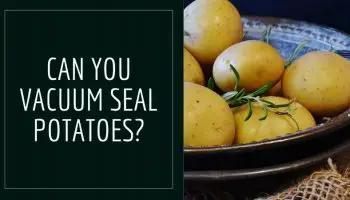Vacuum sealing is a highly reliable method of preserving foods. You can preserve meats, cheese, rice, veggies, fruits, and many other things for as long as 2 weeks, 3 months, and even years in this way. This has made vacuum sealers grow in popularity in many kitchens.
A vacuum sealer works by drawing out all the air in a package to leave food in a vacuumed space. The lack of air will prevent the growth of microorganisms making food last for much longer than it normally would when preserved in other ways.
If you have a vacuum sealer, you have seen how the sealing process works and wondered if it would work for liquids. Wouldn’t they be pulled right in?
Read along to get your question answered and learn four simple ways of doing it right.
Can you vacuum seal liquids?
You can vacuum seal liquids and it’s easier than you may think. There are several ways to do it too. You can package and freeze the liquid first, make ice cubes of your liquid, use a liquid blocker strip, or seal with a chamber vacuum sealer. Whether you are preparing or preserving soups, marinades, or wet foods, vacuum sealing is still possible and efficient with no need to worry about messes. The method will preserve the freshness, taste, and flavors of the liquids.
Methods of vacuum sealing liquids
There are several methods that you can use to vacuum seal liquids. Let’s look into each one of them and how they work.
You can choose the most convenient for you whenever you want to vacuum seal your liquids if you have more to save for another day.
Freezing
If you were to simply seal liquids using a vacuum sealer, they would be sucked right into the machine which would ruin it and waste your food at the same time. This is where freezing comes in.
The freezing method will require you to freeze your liquids before vacuum sealing them. This keeps them solid and hard to be pulled into the machine.
Freezing liquids before sealing is also efficient because liquids expand after freezing. This prevents any chances of your liquids expanding later after sealing which could compromise the seal.
So what you do is: First pour your liquids into a bag. Place the open bag in the freezer and let it turn solid. Pick it up and vacuum seal it with your vacuum sealer machine.
Ice cubes
An alternative to freezing is making ice cubes. Pour your liquids into an ice cube tray and put them in the fridge.
When they are solid, put them in the bag, and vacuum seal it.
Chamber Vacuum Sealer
A chamber vacuum sealer is bigger and more expensive than a vacuum sealer machine. It can seal many bags at once and it’s very efficient at sealing.
The good thing about this machine is that it will not draw air out of the bag so your liquids will stay intact. It will instead work by reducing pressure inside the bag which will pull out only the air gradually.
The liquids are left in the bag as the air is vacuumed out and the bag is sealed shut. The process is fast and there is no mess left to clean. This one is especially useful for sous vide.
It works great for restaurants and you can invest in one if you frequently seal liquids (and other foods too) because it is worth it and a time saver.
Liquid blocker strips
You can buy some liquid blocker strips for the times you want to vacuum seal liquids. The strips are small plastic apparatus that can fit across vacuum bags. They are designed to keep the liquid down as you vacuum seal to prevent it from getting pulled out.
What you do is you put the contents in a bag, then place the strip at the top. It should be above the liquid but below the seal.
You can then vacuum seal your bag. The strip will allow air to be drawn out while keeping the liquid in the bag.
It will also be sealed inside the bag together with the liquid. You will need to have different strips for each bag if you are sealing multiple bags.
Liquid blocker strips can usually withstand high temperatures so they are safe for sous vide. Another good thing about the strips is that they are washable. You can wash them after use and keep them for later use.
Benefits of vacuum sealing liquids
Vacuum sealing your liquids will be highly beneficial to you in many ways and the best of all is how it will preserve the freshness and taste.
Whether you prepared more soup or have some leftover stew, you can vacuum seal it for another day. The method will keep all the flavor and freshness of your food intact until when you need to eat it again.
Your liquids can last as long as two years but they will still have the same tasty feel they had when you prepared them. They will not have any disappointing freezer burns either.
Early bulk preparations of your soups save time and money. You can easily meal prep in advance while enjoying the delicious foods package by package according to your meal planning. And this is a win-win for you.
Recap
Liquids can be vacuum sealed and it’s so easy and mess-free at the same time. You only need to choose the method that works best for you.
You can use liquid block strips to keep the liquids from coming up, freeze the liquids before vacuum sealing, turn them into ice cubes first, or simply use the chamber vacuum sealing machine.
The chamber vacuum sealing machine is a more expensive method compared to the rest but investing in one is worth it if you seal many liquids frequently. It is fast and very efficient for many bags.
| # | Preview | Product | Price | |
|---|---|---|---|---|
| 1 |

|
Chef Preserve Vacuum Sealer (Vacuum... | $99.00 | Buy on Amazon |
| 2 |

|
2023 Updated Vacuum Sealer Machine,... | $25.10 | Buy on Amazon |
| 3 |

|
Nesco Deluxe Food VS-12 Vacuum Sealer,... | $114.57 | Buy on Amazon |
| 4 |

|
FRESKO Smart Vacuum Sealer Pro, Full... | $79.91 | Buy on Amazon |
| 5 |

|
Pyukix Vacuum Sealer Machine, Food... | $89.99 | Buy on Amazon |



![Can You Vacuum Seal Tomatoes? [The Proper Way!]](https://vacuumsealerzone.com/wp-content/uploads/2021/08/Can-You-Vacuum-Seal-Tomatoes-350x200.jpg)